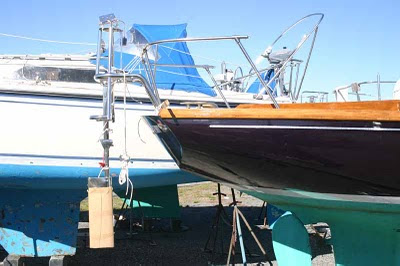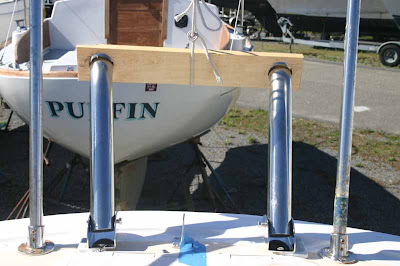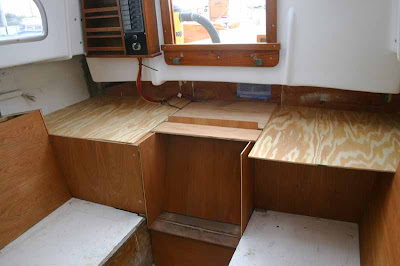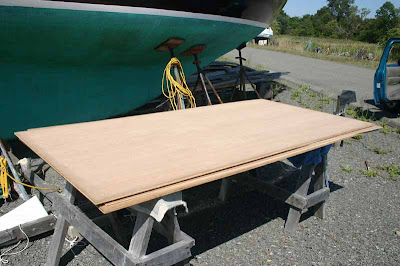Not me of course. A friend of mine who charters on his Hinckley 49 was desperate to get a bunch of work done before heading south. So I spent last weekend working on other-peoples-boats.
I did manage to break away last Sunday afternoon and visit
Jenny. While there I installed two pieces of sound insulation around the engine. I had heard good things about this insulation and when I ordered it I expected it to be quite heavy and dense. Instead, it looks like... well like the 3200 square feet of insulation that I already own for general hull insulation. Not exactly of course. The sound insulation has slightly smaller 'cells' in the foam than what I already own, it is lined with an aluminum foil and it has an adhesive on one side already.
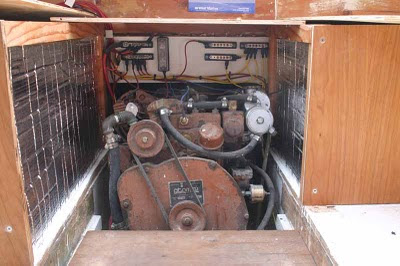
It looks like nice stuff and I have heard good things about it so we will see. The Atomic Four doesn't really need sound proofing. It is pretty quiet already but this should make it a bit nicer. I would be reluctant to put my general foam insulation that close to the engine too. The temperature rating is quite high but the aluminum foil lined insulation has to be a better choice.
Anyway, the sound insulation installs super easy. Cut to fit. Peel the backing. Stick in place. No complaints so far.
So this latest weekend I had to cram in all the household stuff I put off last weekend and get started on my winter cover. With October quickly wrapping up I was getting more than a little anxious about getting the boat covered.
Last year's winter cover worked pretty well; even during that storm with the 90 mph winds. The one fault was the green garden stakes which were totally inadequate for keeping the base of the structure where it belonged. The structure simply pushed over the garden stakes, flattened them and settled into a variety of 'S' curves which I had to straighten out several times.
So this Saturday I bought 14 - 4 foot sections of concrete re-bar and drove 3 feet of the bar into the ground. We will see if this solves the wandering problem.

After that I managed to match up the frame halves, bolt them together and stage them for erection. Why does it sound so porno to say 'erection'?...
Sunday was the first windless day in two weeks which was a blessing. It was an easy day raising the frames into position. By starting in the middle, I was able to place the ladder at the ends of the boat and hold the ridge joint in one hand, walk up the ladder. There was enough friction where the bows slot into the base frame for the bows to stay in position while I walked down and screwed temporary braces to hold the frames vertical.

Once I had them all up I installed diagonal cross bracing below the sheerline. Then I dropped the 3 section ridge pole into the slots and secured it with the same metal hardware I used last year. After that I installed another row of diagonal cross members above the sheerline. The whole operation took about 5 hours.
So that is the good news.
The bad news is that the structure is not going to last many more seasons. There are a variety of reasons for this.
For one, the untreated bows all warped to varying degrees. It is cheap strapping material so I really shouldn't be surprised. There is definitely some stress due to shrinkage which has weakened the construction adhesive bond around the filler blocks placed between the inner and outer strapping that make up the bow.
Secondly, the 1/2 inch plywood gussets (3/8 on two where I ran out of 1/2 inch scrap plywood) that connect the two opposing bows together take a lot of stress during 'erection' and the plywood is weakening. There was some groaning and cracking noises this time. Everything held together but I was a little concerned. Once in place I am not too worried about the joint but grabbing one bow and walking up focuses a lot of strain on the gusset joint when the bows are more horizontal than vertical. If I use the frames again I will have some repair work to do first.
Third, I am an amateur construction hack and the structure is not a model of precesion and quality. That is just the way it is.
Overall, I am still very impressed with the design of the structure (not my design) but I don't think it lends itself that well to breaking down every spring. There is too much wear and tear during the assembly. I am sure I could have left it up (and coverd from the sun and rain) for ten years with no major problems. It is the up and down and leaving them untreated and outside under the boat has taken its toll on the cheap strapping. The only real solution is a permanent structure, a boat barn, which keeps moving up on my priorities list.

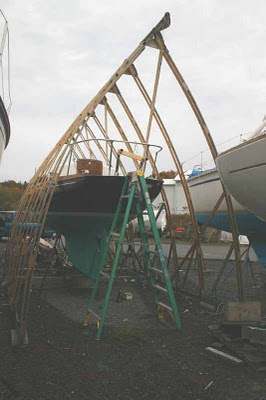
Rain fell in the afternoon and I wasn't really excited about attaching the end poles or pulling the tarp over anyway so that's all I got done. Next week I need to finish up the cover and take a good look at what needs to be done before next spring's launching.
and that's it.



























